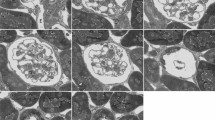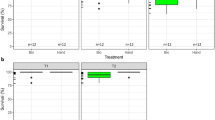Abstract
IN the course of investigations into the site at which renin is found in the kidney it became necessary quickly to separate glomeruli from other renal elements. Previous experiments on fat embolism had shown that in the kidney fat particles were restricted largely to glomeruli. It therefore seemed possible that if particles of the right size could be introduced into the renal circulation they would lodge in the glomeruli. This consideration, together with an early admiration for the experiment in which the function of the otocyst and otolith were demonstrated by inducing the crayfish (Palinurus) to use a particle of magnetic oxide of iron as an otolith, suggested that if the particles introduced into the renal circulation were magnetic it would be possible to separate the glomeruli with a magnet. This has been done. Since it can be done quickly and without much greater disturbance than is involved in mechanically disrupting the kidney, the method may be useful to others interested in locating enzymes in the kidney.
This is a preview of subscription content, access via your institution
Access options
Subscribe to this journal
Receive 51 print issues and online access
$199.00 per year
only $3.90 per issue
Buy this article
- Purchase on Springer Link
- Instant access to full article PDF
Prices may be subject to local taxes which are calculated during checkout
Similar content being viewed by others
References
McEwen, L. M., J. Physiol., 131, 678 (1956).
Author information
Authors and Affiliations
Rights and permissions
About this article
Cite this article
COOK, W., PICKERING, G. A Rapid Method for separating Glomeruli from Rabbit Kidney. Nature 182, 1103–1104 (1958). https://doi.org/10.1038/1821103a0
Issue Date:
DOI: https://doi.org/10.1038/1821103a0
This article is cited by
-
Spontaneous release of glycosylphosphatidylinositol (GPI)-anchored renal dipeptidase from porcine renal proximal tubules
Archives of Pharmacal Research (2002)
-
Release of renal dipeptidase from rabbit renal proximal tubules and its inhibition by gentamicin
Archives of Pharmacal Research (1999)
-
Differences in enzymatic and mechanical isolated rabbit renal proximal tubules: Comparison in long-term incubation
In Vitro Cellular & Developmental Biology (1990)
-
Primary rabbit kidney proximal tubule cell cultures maintain differentiated functions when cultured in a hormonally defined serum-free medium
In Vitro Cellular & Developmental Biology (1989)
-
Primary cultures of rabbit renal proximal tubule cells: I. Growth and biochemical characteristics
In Vitro Cellular & Developmental Biology (1989)
Comments
By submitting a comment you agree to abide by our Terms and Community Guidelines. If you find something abusive or that does not comply with our terms or guidelines please flag it as inappropriate.



